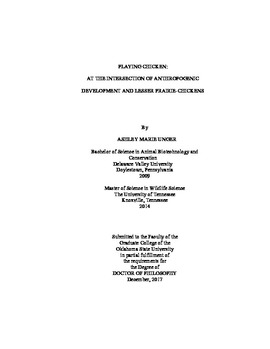| dc.contributor.advisor | Fuhlendorf, Samuel Dean | |
| dc.contributor.author | Unger, Ashley Marie | |
| dc.date.accessioned | 2018-06-18T16:02:26Z | |
| dc.date.available | 2018-06-18T16:02:26Z | |
| dc.date.issued | 2017-12 | |
| dc.identifier.uri | https://hdl.handle.net/11244/300075 | |
| dc.description.abstract | Ecology and natural history have long documented the spatial arrangement of organisms over time. Our definition of space and time, or scale, will determine what ecological relationships we are able to detect between organisms and their environment. No one scale is capable of fully capturing the complexities of these relationships; therefore it is critical that research is conducted at multiple scales. We assessed the relationship between the imperiled lesser prairie-chicken (hereafter LPC; Tympanuchus pallidicinctus) and its environment at scales ranging from their distribution to the space an animal could encounter in 1 hours' time. Distribution-wide studies require data of sufficient quantity and quality that is geographically representative of the species' space use; however these data are often expensive to collect. Freely available citizen science observations of LPCs from eBird and professionally collected observations from an aerial survey produced potential species distributions that were supported (test omission rate ≤ 15.6%) and had a high degree of similarity to one another (I = 0.956), indicating that citizen science data from eBird could be used as a low-cost supplement to species distribution modeling efforts. Environmental variables that are important and consistent in the direction of their relationship to the animal across scales are indicators of primary drivers of animal space use. Birds responded negatively to cropland and positively to land enrolled in the conservation reserve program (CRP) across their distribution, and in weekly, daily, 4 hourly, and hourly movements and habitat selection. Moreover, the CRP facilitated LPC movement across roads, which were found to be a significant barrier to movement. Birds minimized time spent crossing roads and power lines, but did not respond to the proximity of residential areas or an oil or gas wells. LPCs were strongly tied to their breeding grounds across all scales, which could be used as a basis for conservation planning. Our results indicate that humans have significantly impacted the landscape for LPCs across a range of spatial and temporal scales. LPC conservation efforts should engage with policy and focus on understanding the human role in shaping the arrangement of anthropogenic features and vegetation on the landscape. | |
| dc.format | application/pdf | |
| dc.language | en_US | |
| dc.rights | Copyright is held by the author who has granted the Oklahoma State University Library the non-exclusive right to share this material in its institutional repository. Contact Digital Library Services at lib-dls@okstate.edu or 405-744-9161 for the permission policy on the use, reproduction or distribution of this material. | |
| dc.title | Playing chicken: At the intersection of anthropogenic development and lesser prairie-chickens | |
| dc.contributor.committeeMember | Elmore, R. Dwayne | |
| dc.contributor.committeeMember | Davis, Craig A. | |
| dc.contributor.committeeMember | Papes, Monica | |
| dc.contributor.committeeMember | Minghetti, Matteo | |
| osu.filename | Unger_okstate_0664D_15507.pdf | |
| osu.accesstype | Open Access | |
| dc.type.genre | Dissertation | |
| dc.type.material | Text | |
| thesis.degree.discipline | Natural Resource Ecology and Management | |
| thesis.degree.grantor | Oklahoma State University | |
